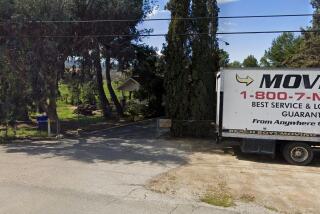Tip by Youth Prompts Renewed Body Search at Mass Murder Scene
SAN ANDREAS, Calif. — Acting on a tip from a 15-year-old boy who once worked on the property, authorities Monday said they will excavate several new sites in the search for bodies at the remote mountain home of suspected mass murderer Leonard Lake.
Among the sites to be dug up are a six-foot pit believed to be hidden under a cinder-block bunker and two smaller areas near a dog pen and some water tanks.
The 15-year-old boy, Scott Mosher, of the nearby town of West Point, told authorities during a tour of the site Saturday that he had once helped dig a 4-by-8-foot trench near the water tanks and a smaller trench near the animal shed, a Calaveras County official said.
The official also acknowledged that Mosher’s description of the pit under the bunker was confirmed by a 19-year-old Sacramento woman who had once done some work for Lake.
In other developments Monday:
- State Atty. Gen. John Van de Kamp confirmed at a San Francisco press conference that two more partial bodies have been removed from the site, bringing the number of bodies to five. In addition, about 20 pounds of bone fragments have been found in the area, accounting for what authorities say are at least three more bodies.
- Van de Kamp, Calaveras County Sheriff Claud Ballard and San Francisco Police Chief Cornelius Murphy also told reporters that they have identified 19 people who may be among those kidnaped and killed over a two-year period by Lake and his suspected accomplice, Charles C. Ng.
- Calaveras County Sheriff Sgt. Ron McFall said his agency later this week will start trying to identify 21 other people, all young women, who were featured in suggestive photos tacked on the walls of the bunker, which Lake apparently used to imprison some of his captives.
- Ballard and Murphy also flatly rejected a request for immunity by Lake’s ex-wife, Claralyn (Cricket) Balazs, 28, of South San Francisco. Balazs, who surrendered some explicit videotapes taken from the cabin after Lake’s arrest and apparent suicide, said through her attorney on Sunday that she would continue cooperating with police only if promised she would not later be charged with any crime.
“I’m not in the business of giving anyone immunity,” said Ballard. After at first declining to name Balazs as a suspect in the case, he added: “Anyone would definitely be a suspect if they removed items from the scene . . . (so) I guess she’s a suspect.”
Lake slipped into a coma after apparently taking poison shortly after his arrest June 2 over a tool stolen from a South San Francisco lumber yard. Four days later, he died when he was removed from life-support equipment. Ng fled the lumber yard before police arrived and is now the subject of a worldwide manhunt.
Van de Kamp said that in addition to the three bodies exhumed last week--a 25-year-old black man with a gunshot wound to the head, a 30-year-old black man and a white woman of undetermined age--investigators have unearthed a second woman and a child. No further identifying features were released. None of the 19 missing persons linked to Lake are black.
Purposely Vague
Indeed, authorities were purposely vague on all of their identifications--refusing to confirm or deny lists of potential victims compiled by reporters and declining to explain the ever-changing number of suspected victims.
“It is a strange kind of investigation,” Van de Kamp said. “As you know, this (the number of suspected victims) is very fluid and we are not suggesting this is the end of it. I prefer that we be as precise as possible rather than speculate.”
Murphy said that 10 of the suspected victims were from San Francisco, some of them believed to have been lured to their deaths when Lake and Ng answered newspaper classified advertisements. McFall said four others had recently moved to Northern California from the San Diego area, and three more were from the San Jose area. The hometowns of two others--the two black men--were unknown.
Police are using a variety of evidence to try to identify the remains found at the site. In addition to the photos on the bunker wall, investigators are using photo scrapbooks kept by Lake, his diary, videotapes he made with gear he may have stolen from one of his victims, a cache of credit cards and drivers licenses found in the cabin and a computer and some computer data disks also found in the cabin.
Not Among 19
McFall, who is leading the investigation for Calaveras County, said women pictured in the bunker photos are not counted among the 19 suspected victims because he knows of at least one local girl who posed for Lake but was not assaulted.
However, that woman posed fully clothed, sources said, while the photos on the bunker walls were of women in bikinis, in suggestive lingerie, or in the nude.
Identifying most of the remains uncovered at the scene will be extremely difficult, investigators said, because most of the victims’ bodies apparently were burned and then chopped into pieces, perhaps with a curiously stained mattock found recently by investigators.
A mattock is a soil-loosening tool similar to a pickax, but with a broad, flat blade on one side and a narrow, ax-like blade on the other.
“There’s a good possibility there are people we will never identify,” said Ballard. “We’re dealing with such small bone fragments. How can you identify someone when all you have to work with is a fingernail or something?”
Despite such gruesome obstacles, Van de Kamp stressed the potential severity of the case.
“I underscore ‘potential’ because there’s so much left to be resolved,” he said. “Before we put the final stamp on this, we have a lot of work to do. The early evidence is that this is a very large, bizarre, unusual case; the potential for one of the largest mass murders in the state is there.”
Louis Sahagun reported from San Andreas and Mark A. Stein reported from San Francisco.
More to Read
Sign up for Essential California
The most important California stories and recommendations in your inbox every morning.
You may occasionally receive promotional content from the Los Angeles Times.










